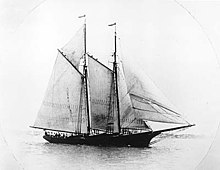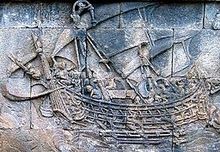


A fore-and-aft rig is a sailing vessel rig with sails set mainly along the line of the keel, rather than perpendicular to it as on a square rigged vessel.
Description
Fore-and-aft rigged sails include staysails, Bermuda rigged sails, gaff rigged sails, gaff sails, gunter rig, lateen sails, lug sails, tanja sails, the spanker sail on a square rig, and crab claw sails.
Fore-and-aft rigs include:
- Rigs with one mast: the proa, the catboat, the sloop, the cutter
- Rigs with two masts: the ketch, the yawl
- Rigs with two or more masts: the schooner
Barques and barquentines are partially square rigged and partially fore-and-aft rigged.
A rig which combines both on a foremast is known as a hermaphroditic rig.
History
Austronesia

The fore-and-aft rig is believed to have been developed independently by the Austronesian peoples some time after 1500 BC with the invention of the crab claw sail. It is suggested that it evolved from a more primitive V-shaped "square" sail with two spars that come together at the hull. Crab claw sails spread from Maritime Southeast Asia to Micronesia, Island Melanesia, Polynesia, and Madagascar via the Austronesian migrations. Austronesians in Southeast Asia also later developed other types of fore-and-aft sails, such as the tanja sail (also known as the canted square sail, canted rectangular sail, or the balance lug sail).
Their use later spread into the Indian Ocean since the first millennium, among vessels from the Middle East, South Asia, and China.
Europe
The lateen was developed in the Mediterranean as early as the 2nd century AD, during Roman times. It became common by the 5th century.
The square rig had predominated in Europe since the dawn of sea travel, but in the generally gentle climate of southern Europe and the Mediterranean Sea during the last few centuries before the Renaissance the fore-and-aft began to replace it. By 1475, its use increased, and within a hundred years the fore-and-aft rig was in common use on rivers and in estuaries in Britain, northern France, and the Low Countries, though the square rig remained standard for the harsher conditions of the open North Sea as well as for trans-Atlantic sailing.
See also
References
- Casson, Lionel (1995): "Ships and Seamanship in the Ancient World", Johns Hopkins University Press, ISBN 978-0-8018-5130-8, pp. 243–245
- Knight, Austin Melvin (1910). Modern seamanship. New York: D. Van Nostrand. pp. 507–532.
- ^ Campbell, I.C. (1995). "The Lateen Sail in World History". Journal of World History. 6 (1): 1–23. JSTOR 20078617.
- Hobson, John M. The Eastern Origins of Western Civilisation. Cambridge University Press,2004, p. 58, ISBN 978-0-521-54724-6, ISBN 0-521-54724-5 "
- Agius, Dionisius A. (2008). Classic Ships of Islam: From Mesopotamia to the Indian Ocean. BRILL. pp. 141, 160, 211–212, 382. ISBN 978-9004158634.
- Whitewright, Julian (April 2012). "Technological Continuity and Change: The Lateen Sail of the Medieval Mediterranean". Al-Masāq. 24 (1): 1–19. doi:10.1080/09503110.2012.655580.
External links
| Types of sailing vessels and rigs | |||||||||||||||||
|---|---|---|---|---|---|---|---|---|---|---|---|---|---|---|---|---|---|
| Overviews | |||||||||||||||||
| Sailing rigs | |||||||||||||||||
| By sailing rigs | |||||||||||||||||
| Multihull vessels | |||||||||||||||||
| Naval and merchant sailing ships and other vessels (by origin date) |
| ||||||||||||||||
| Fishing vessels | |||||||||||||||||
| Recreational vessels | |||||||||||||||||
| Special terms | |||||||||||||||||
| Other types | |||||||||||||||||
| Related | |||||||||||||||||
| Sails, spars and rigging | |||||||
|---|---|---|---|---|---|---|---|
| including limited use, outdated | |||||||
| Rigs |
| ||||||
| Sails (sailing rigs) |
| ||||||
| Spars |
| ||||||
| Rigging |
| ||||||
